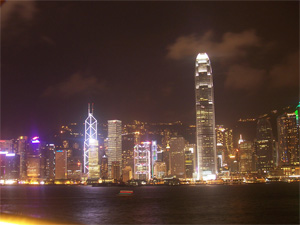China and Hong Kong:
Same Country Two different Worlds
By Lindsay Kuhlmann
 It was
around ten
o’clock in the morning when
I
stepped off
the MV Explorer and into Hong
Kong. My
excitement for
this moment had been building for days and the night before I found it
extremely difficult to allow my brain to go into sleep mode. I had
heard all
about Chinese culture from various professors, read through guide
books, and
painted a picture in my head of what to expect. It was
around ten
o’clock in the morning when
I
stepped off
the MV Explorer and into Hong
Kong. My
excitement for
this moment had been building for days and the night before I found it
extremely difficult to allow my brain to go into sleep mode. I had
heard all
about Chinese culture from various professors, read through guide
books, and
painted a picture in my head of what to expect.
As
I departed the ship I found myself in a truly global city. The ship’s
gangway
lead straight into an up-scale mall with expensive watches and
glittering
jewelry waiting to be bought by rich tourists. My first impression was,
“This
could be New York.” I
walked for
fifteen minutes and never escaped the stores. Dior, Prada and Coach all
made an
appearance in this global city. Thirty minutes into the city I knew I
had to
visit mainland China
in order to see a more traditional form of Chinese culture.
It
took me one hundred and eighty U.S dollars to buy a round trip ticket
to Guilin.
I had to take a very advanced ferry to the airport and then a
forty-five minute
flight. When I made it to the mainland I found myself in a different
world.
Every car on the street was from the 1980’s. I didn’t see any Bentley’s
or
Mercedes like I had in Hong Kong. Although I
was in a
city with lots of tourism, nothing seemed like it had been built
yesterday.
Most of the buildings were made of cement that was crumbling around the
edges.
The sidewalks had huge potholes and if you didn’t watch your step you
would
easily trip and fall. All these sights can be partly explained by Sean
Gallagher in Beijing’s Urban Makeover: the ‘hutong’ construction.
“Under the rule of Mao Tse-tung, during the Cultural Revolution, very
little
construction took place throughout the country" (pg 1,
Gallagher). Even
the
hotel I stayed in for fifteen dollars a night, which was considered
brand new,
had to have been built twenty years ago.
The
day after arriving in Guilin
my
travel companions and I took a ferry boat ride down the Li River. As we
followed a line of boats, businessmen riding on bamboo rafts approached
the ferries
trying to sell jade Buddhas. The only English they knew seemed to be
“Hello,
Hello!” which they would yell in order to get our attention.
After
the river boat ride we went to a “minority people’s village” called
Shang-gr-la.
The village had people dressed up in tribal outfits while performing
traditional dances and making tradition crafts that were for sale.
While it did
seem a bit like a tourist trap, I found the houses where the villagers
lived a
far cry from the new skyscraper apartment buildings in Hong
Kong.
After visiting this village I felt that I had seen what ancient Chinese
culture
might have been like for these people.
By
ten o’clock that night I was headed once again for the global city of Hong
Kong. When I arrived back from Guilin
I entered a city with skyscrapers illuminated by color-changing lights
and
expensive shopping areas. I felt as if I was in a different world from Guilin.
Yet both these worlds were found within the same country and represent
Chinese
culture. Through my experience of visiting China
and seeing such different parts of the country I found that guide
books,
professors, and my expectations could not prepare me for
differentiation I
discovered between a transnational city and a vernacular city.
|

 It was
around
It was
around